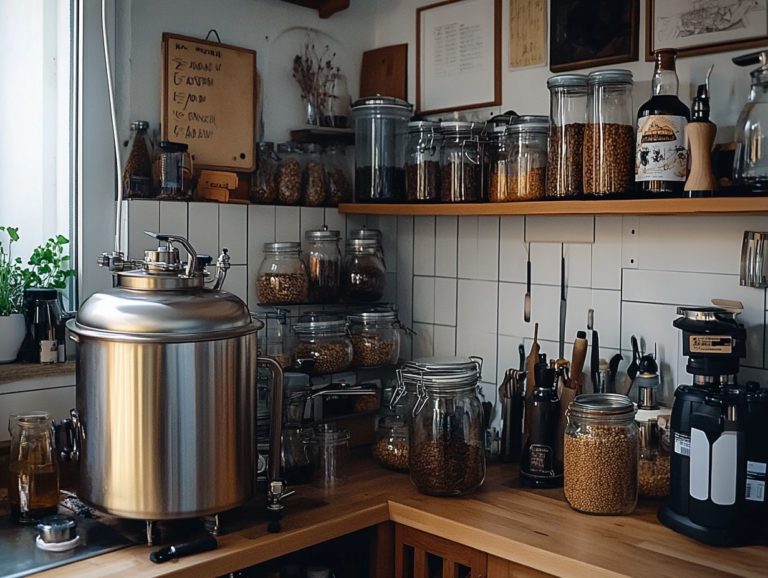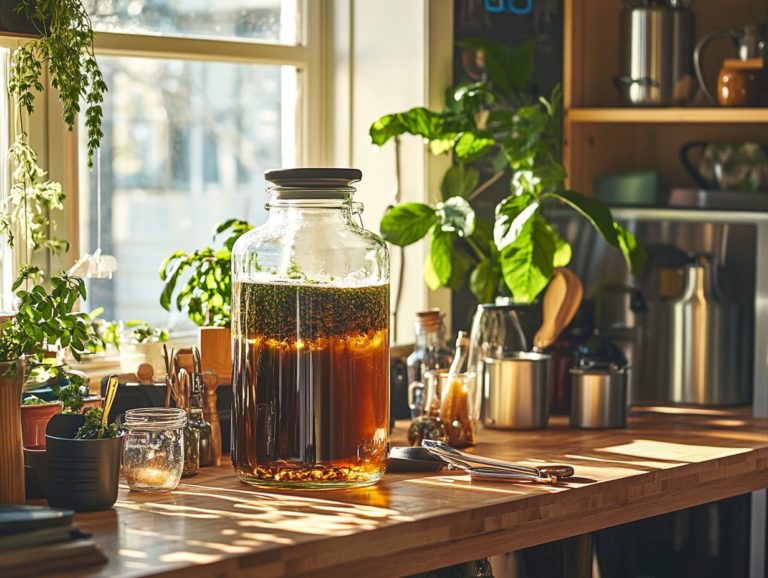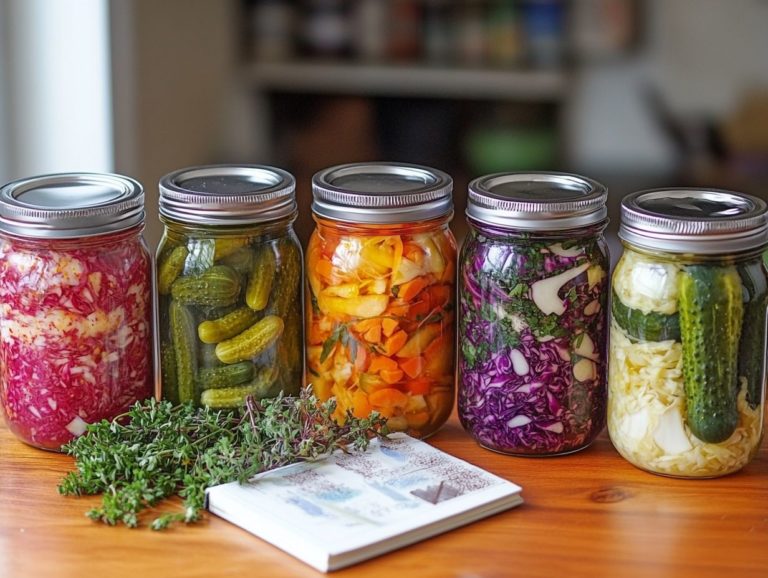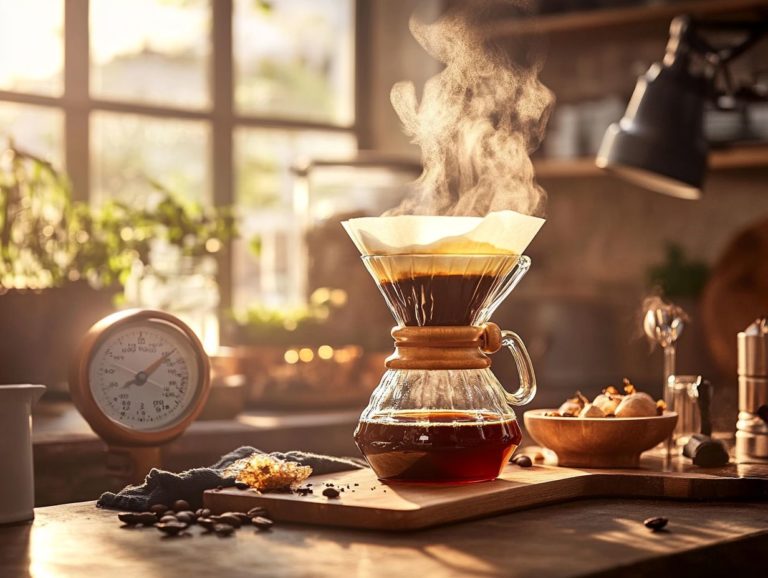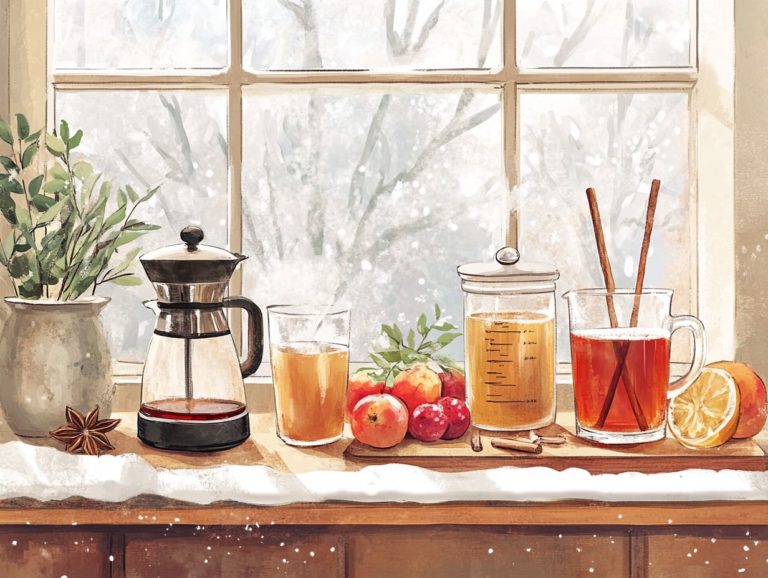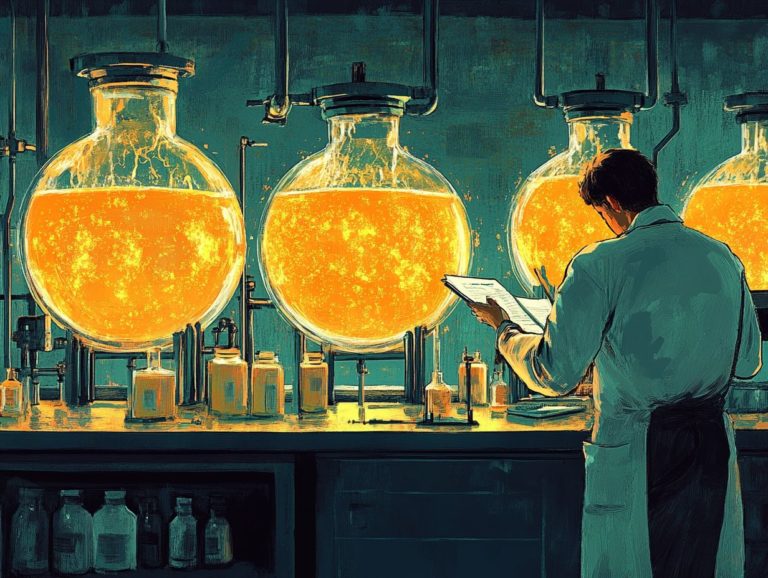Maximizing Aroma: Home Brewing Tips
Aroma is crucial to your coffee experience, affecting not only the scent but also the overall flavor profile, much like the hop aroma in craft beer.
From selecting the right beans to perfecting your brewing techniques, each stage of the coffee-making process significantly influences the aroma. This exploration delves into how aroma enhances flavor, the factors that shape it, and the best practices for selecting, grinding, and brewing your coffee.
Whether you re just starting out or you ve been savoring coffee for years, get ready to uncover amazing tips to elevate your home brewing and unlock the full aromatic potential of every cup.
Contents
- Key Takeaways:
- Why is Aroma Important in Coffee?
- Choosing the Right Beans for Maximum Aroma
- Grinding Techniques for Enhanced Aroma
- Conclusion
- How Does Grind Size Affect Aroma?
- What is the Best Way to Grind Coffee for Maximum Aroma?
- Brewing Methods for Optimal Aroma
- What Brewing Methods Bring Out the Most Aroma?
- How to Adjust Brewing Time for Aroma?
- What Temperature is Best for Aroma Extraction?
- Additional Tips for Maximizing Aroma in Home Brewing
- How to Clean Your Coffee Equipment for Better Aroma?
- What Are Some Common Mistakes That Can Affect Aroma?
- How to Experiment with Different Factors to Find Your Perfect Aroma?
- Frequently Asked Questions
- What is the role of aroma in home brewing?
- How can I maximize the aroma in my home brewed beer?
- What ingredients are best for achieving a strong aroma in my beer?
- Is it possible to add aroma to my beer after it has been brewed, such as in an IPA or NEIPA?
- Are there any tips for preserving the hop aroma in my home brewed beer?
- Can using certain types of yeast affect the aroma and flavor profiles of my beer?
Key Takeaways:
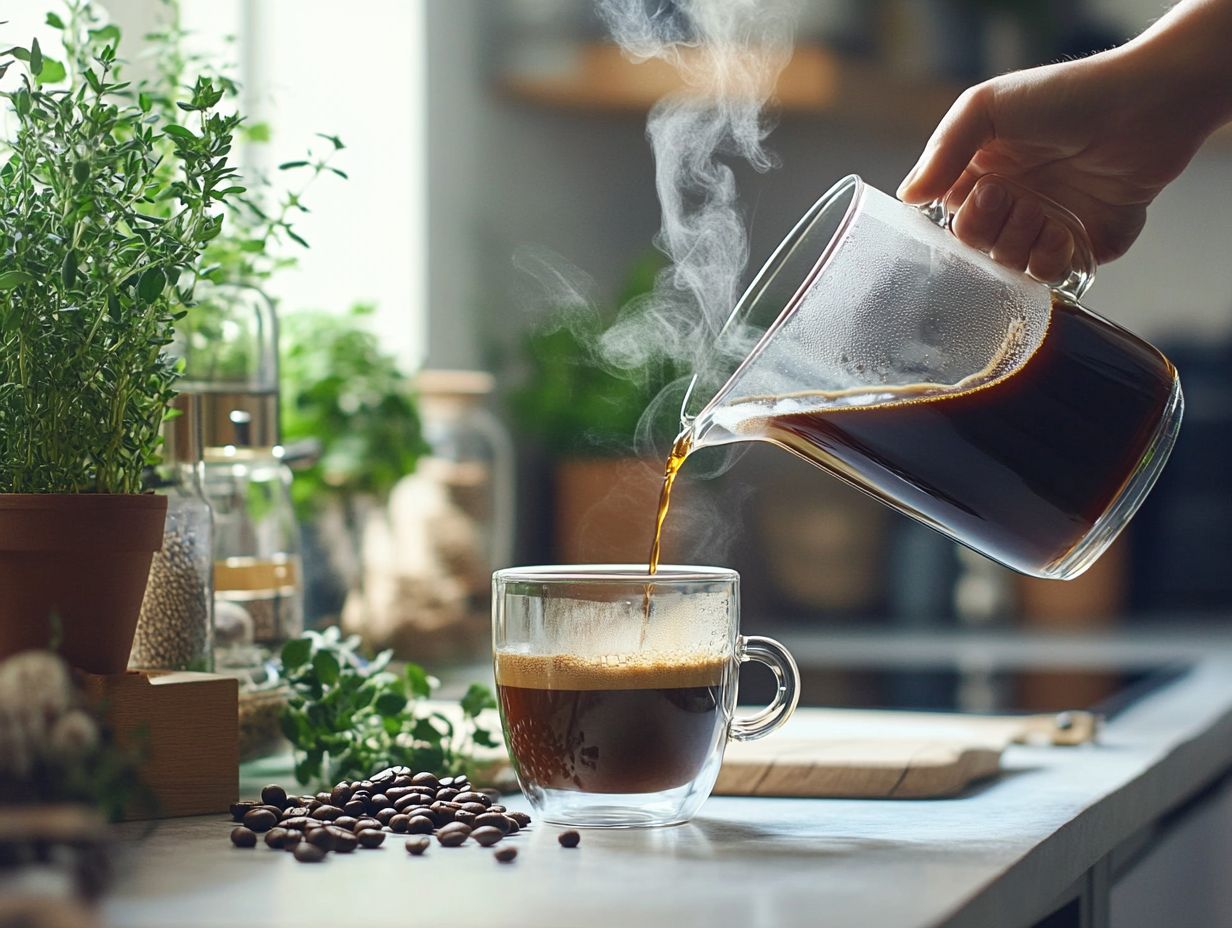
- Choosing the right beans is essential for maximizing aroma in your home brewed coffee. Look for beans with a strong aroma and store them properly to preserve their freshness.
- Grind size and brewing techniques play a crucial role in enhancing aroma. Experiment with different grind sizes and brewing methods to find the perfect balance for your taste preferences.
- Properly cleaning and maintaining your coffee equipment can greatly improve the aroma of your home brewed coffee. Avoid common mistakes such as using old, stale beans or brewing at the wrong temperature to achieve the best aroma possible.
Why is Aroma Important in Coffee?
Aroma is pivotal to the overall coffee-drinking experience, much like the hop flavor in IPA or NEIPA craft beers. It profoundly influences your perception of taste and satisfaction.
The aromatic compounds in coffee beans craft an array of flavor profiles that can transport you through a spectrum of sensations, from fruity and floral to earthy and nutty. Just as well-preserved hops enhance the aroma in a hop-forward beer, the aroma of coffee is vital for elevating your brewing experience and ensuring each cup leaves a lasting impression.
How Does Aroma Affect the Taste of Coffee?
Aroma plays a pivotal role in shaping how you perceive the taste of coffee, engaging your olfactory senses to craft a truly immersive flavor experience. The flavor compounds released during the brewing process have the power to significantly enhance or alter the taste you experience, much like the vital hop oils from dry hopping do in craft beer.
This relationship between aroma and taste is deeply rooted in the science of flavor perception. Your brain synthesizes inputs from both your taste buds and olfactory receptors. In the realm of craft beer, brewers carefully select various hops that impart aromatic compounds, dramatically transforming your tasting experience.
The synergy of these compounds shapes your initial impression as you take a sip and influences the beer’s finish. This results in a multifaceted profile that tantalizes your palate, similar to the effects of hop creep in beer.
Ultimately, your journey from brewing to tasting becomes an enriching exploration of aromas, elevating your appreciation for complex flavors.
What Factors Affect the Aroma of Coffee?
The aroma of coffee is influenced by various factors, including the brewing methods you choose, the grind size of the beans, and how you store your coffee. Much like how the storage of hops affects flavor stability in craft beer, using proper storage techniques is essential for preserving the aromatic qualities of your coffee, similar to techniques used in hop storage.
Take grind size, for example. It plays a crucial role in determining how much of the coffee’s volatile compounds responsible for aroma are extracted during brewing. This is similar to how the size and processing of malt can alter the aroma profile during beer production. The brewing method you select whether it s pour-over, French press, or espresso can significantly shape the final fragrance, just like how different yeast strains impart unique scents in craft beer.
Freshness and exposure to air can diminish the aromas of both coffee and beer. Therefore, using airtight containers and controlling light exposure are practices embraced by both coffee aficionados and beer enthusiasts, similar to using nitrogen-flushed bags in hop preservation.
By grasping these nuances in aroma development, you can truly appreciate the layered complexities that both coffee and craft beer have to offer, akin to the detailed hop assessments conducted by brewers.
Choosing the Right Beans for Maximum Aroma
Selecting the right coffee beans is essential for unlocking the full aromatic potential of your brew. Each variety of bean presents its own unique flavor profile, which can profoundly affect the coffee’s overall aroma. This is similar to how hop varieties impact the aroma in craft beer.
Much like brewers who meticulously choose hop varieties such as Citra or Mosaic to elevate hop flavor in craft beer, you should consider factors like origin, roast level, and processing methods. By doing so, you can ensure a vibrant aroma that enhances your entire brewing experience, akin to achieving optimal hop extraction in beer.
What Types of Beans Have the Strongest Aroma?
Certain coffee beans are celebrated for their robust aromas. Varieties like Arabica typically offer a more complex and fragrant brew compared to the earthier notes of Robusta. This distinction mirrors how different hop varieties, such as Amarillo or Simcoe, impart unique aromas to craft beers. Selecting the right bean is crucial for achieving an optimal aromatic experience.
Arabica beans can present delightful hints of floral and fruity notes, making them a favorite among coffee enthusiasts who crave a vibrant cup that dances on the palate. Similarly, the citrusy zest of Amarillo hops can elevate a beer’s profile, harmonizing beautifully with those delicate coffee aromas.
On the other hand, Robusta’s bold, nutty flavors cater to those who prefer a heartier brew. Heavier hop varieties like Centennial contribute a deeper, more resinous character to ales. Delving into the aromatic profiles of both coffee and hops reveals a captivating intersection of flavors that enriches your enjoyment of each.
How to Store Coffee Beans to Preserve Aroma?
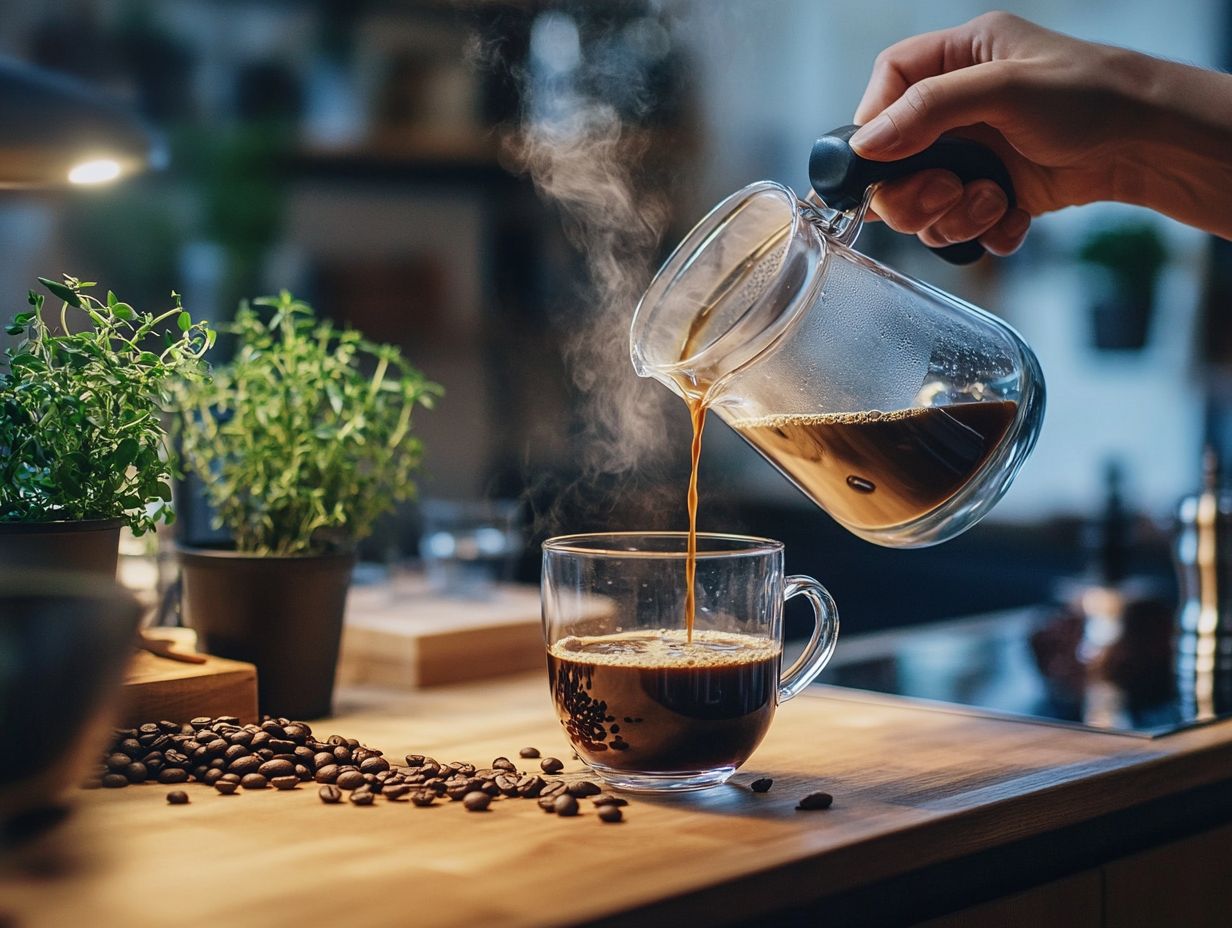
To preserve the delightful aroma of your coffee beans, employing proper storage techniques is essential. Exposure to light, air, and moisture can gradually diminish their aromatic qualities, similar to the challenges faced in hop storage.
Much like brewers use nitrogen-flushed bags to keep hops fresh, you should store your coffee in airtight containers away from direct sunlight. This helps maintain the flavor stability and aromatic richness vital for crafting an exceptional cup.
Consider factors like temperature and humidity for your coffee. Storing your coffee beans in a cool, dark place can significantly enhance their longevity, ensuring that the complex flavors and enchanting aromas developed during the roasting process remain vibrant.
Opting for opaque containers will shield the beans from harmful light, while vacuum-sealed options minimize air exposure. This creates an ideal environment to preserve the essential oils and volatile compounds critical for a brew that truly tantalizes the senses.
Grinding Techniques for Enhanced Aroma
The technique you employ for grinding coffee beans is crucial in elevating the aroma of your brew. The grind size directly influences how flavors are released during the brewing process, much like the careful timing of hop addition during a hop stand.
Selecting the right grind ensures that the aromatic richness of your coffee is fully realized, culminating in a truly satisfying cup. This is akin to the use of different hop varieties such as Cascade or Falconer s Flight in brewing.
Conclusion
Choosing the right coffee beans and employing effective storage techniques are essential for preserving the vibrant aroma of your brew. By understanding these factors, you can significantly enhance your coffee experience.
How Does Grind Size Affect Aroma?
The grind size of your coffee can make or break the aroma, as a grind that is too fine or too coarse can lead to too much extraction or not enough extraction, respectively. Just like the steep temperature is crucial in brewing craft beer, achieving the perfect grind size is essential for optimal flavor extraction, ensuring that those aromatic compounds are released just right. This is similar to the importance of hop oils extraction during the brewing process.
When you consider brewing methods like espresso, pour-over, or French press, the grind size becomes a key player that not only influences the strength of your brew but also the complexity of aromas you can coax out. A finer grind in your espresso enhances that rich, concentrated aroma and allows for quick extraction. Meanwhile, a coarser grind in your French press encourages a smoother, more balanced flavor profile, complete with subtle floral notes. This mirrors the impact of hop creep in beer, where the right grind or steep temperature is critical.
Grasping this relationship can significantly elevate your coffee experience, turning each cup into a masterpiece of sensory delight, akin to the enjoyment of a well-crafted flavored beer.
What is the Best Way to Grind Coffee for Maximum Aroma?
The best way to grind coffee for maximum aroma is by using a quality burr grinder. This tool provides a consistent grind that enhances both flavor stability and aromatic qualities. Just as brewers meticulously apply techniques for hop treatment to achieve the perfect aromas in their beers, a methodical approach to grinding ensures the full spectrum of aromatic compounds is released during brewing. This approach is similar to the specific yeast selection in brewing.
By adjusting the grind size based on your chosen brewing method be it French press, espresso, or pour-over you can unlock distinct aroma profiles, much like a brewer selecting specific hop varieties and timing their additions. For example, a coarser grind can work wonders for immersion methods, allowing for a slower extraction that highlights rich, bold notes. On the flip side, a fine grind is crucial for espresso, where pressure rapidly forces hot water through the grounds, resulting in an intense, aromatic shot.
Thus, understanding the intricacies of grinding not only elevates your coffee experience but also reflects the meticulous attention to detail that goes into creating flavorful brews, akin to the use of well-preserved hops in craft beer.
Brewing Methods for Optimal Aroma
Choosing the right brewing method can make all the difference in your coffee’s aroma. Each technique has the potential to either enhance or diminish the aromatic compounds found in the beans.
Just as dry hopping, late boil additions, and natural cooling techniques can affect hop flavor in craft beer, the brewing method you select will significantly influence flavor extraction and shape the overall aromatic profile of your brew.
What Brewing Methods Bring Out the Most Aroma?
Brewing methods like pour-over and French press are not just techniques; they’re artistry that unlocks the full aroma of coffee, allowing you to extract the optimal flavor from the beans. In the world of craft beer, the different hopping techniques play a crucial role as well, significantly impacting the hop aroma in the final product. This underscores a key truth: the method truly matters in both coffee and beer brewing.
Take the pour-over technique, for example. It employs a slow, controlled process that beautifully highlights the floral and fruity notes of the coffee. It’s akin to dry hopping in beer, where hops are added post-boil to capture their delicate aromas.
Then there s the French press, which immerses the coffee grounds for an extended period, resulting in a rich, full-bodied flavor profile. This is similar to how whirlpool hopping enhances aromatic qualities without overwhelming bitterness, particularly in big beers and hop-forward beers.
These comparative techniques reveal how both coffee and beer artisans meticulously prioritize aroma to create beverages with depth and complexity, ultimately enhancing your sensory experience.
How to Adjust Brewing Time for Aroma?
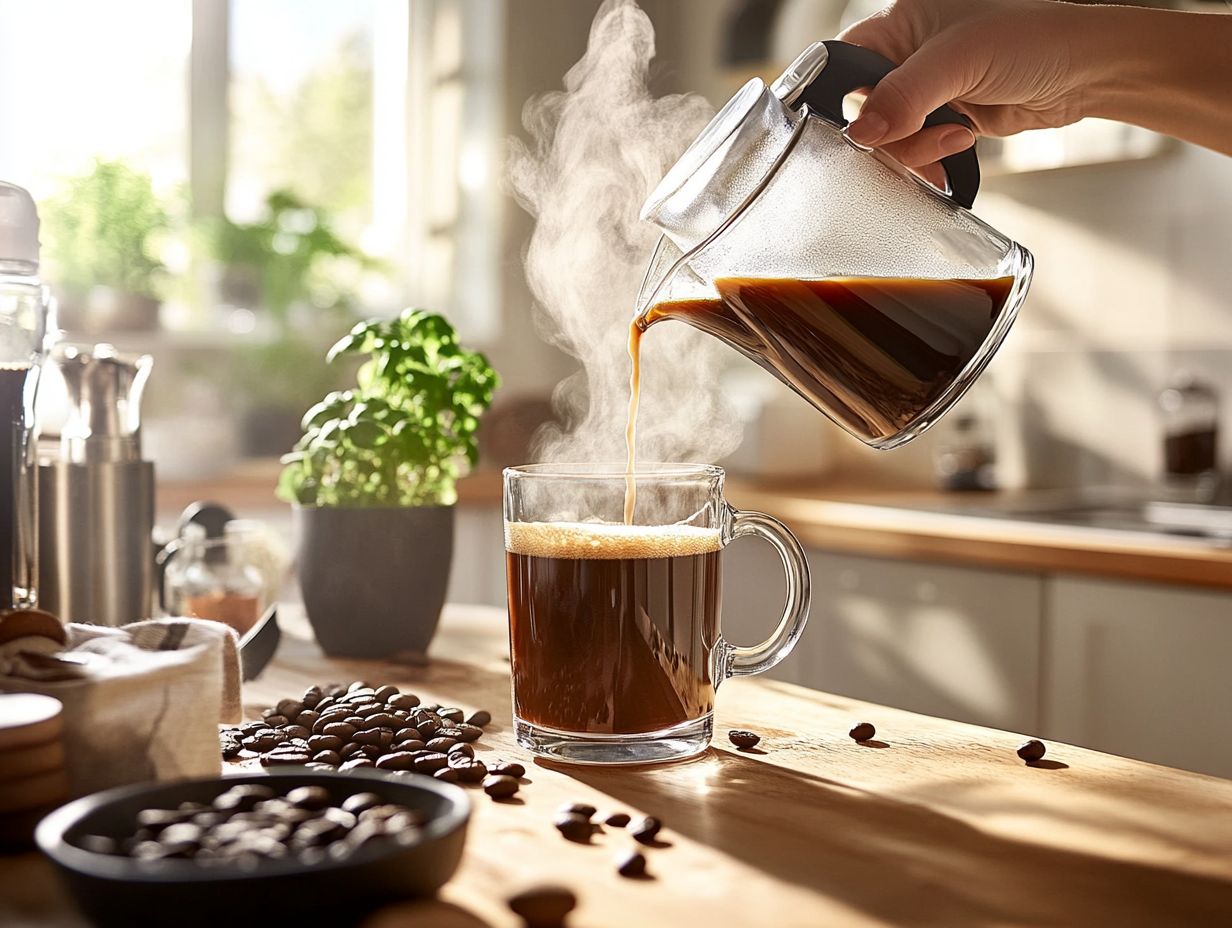
Adjusting your brewing time is crucial for elevating aroma. Longer brewing times can lead to over-extraction, while shorter durations might not fully draw out those aromatic compounds. Think of it like the precision required in timing dry hopping adding hops after the boiling process to enhance aroma and steep additions, which involve soaking ingredients in hot water to extract flavors, during craft beer brewing. Getting the right brewing time is essential for maximizing your aromatic experience in coffee.
Every coffee enthusiast understands that the magic lies in the balance. Just as with craft beer, the subtleties of timing can drastically alter your final cup. If you brew your coffee for too long, you risk developing bitter notes that can overshadow the delicate floral and fruity scents you crave. On the flip side, cutting the brewing time short means you might miss out on those rich, complex flavors that make for a satisfying, full-bodied experience, similar to how inadequate hop treatments can affect the final brew.
The dance of timing mirrors the careful attention that brewers dedicate to hop additions and fermentation periods, highlighting the artistry that connects these two craft beverages.
What Temperature is Best for Aroma Extraction?
The temperature at which you brew coffee is crucial for extracting its aromatic qualities, with optimal temperatures typically hovering between 195 F and 205 F. This precision mirrors what is needed in craft beer brewing, where sub-boiling temperatures can significantly impact the extraction of hop oils. It underscores the importance of careful temperature management in enhancing the aromatic characteristics of both beverages.
When you brew coffee, hitting that ideal temperature not only boosts the extraction of flavorful compounds but also ensures the delicate fragrant oils are fully released. This enriches your overall sensory experience.
In the craft beer brewing process, keeping a close eye on temperature during boiling and fermentation stages can greatly influence the final aroma and taste, particularly in hoppy beers.
By skillfully managing these thermal conditions, you can craft complex flavor profiles that truly delight the palate. It s clear that whether you re a coffee lover or a craft beer enthusiast, prioritizing temperature is essential for elevating aroma and flavor in your chosen brew, much like the intricacies of sub-boiling temperatures in the hop oils extraction process.
Additional Tips for Maximizing Aroma in Home Brewing
To maximize the aroma in your home brewing, you’ll want to pay close attention to detail and employ a few essential techniques that can elevate your coffee experience.
Selecting the right beans is just the beginning; implementing precise brewing methods is equally important. Each step in this process is crucial, much like the careful consideration of hop treatments and hop storage in craft beer for achieving the desired aroma and flavor stability in your final cup.
How to Clean Your Coffee Equipment for Better Aroma?
Keeping your coffee equipment spotless is vital for an extraordinary brew! Any residue buildup can negatively impact the aromatic qualities that you cherish. Similarly, in the craft beer world, ensuring that your brewing equipment is spotless is crucial; hop oils and residue can dramatically alter the intended hop flavor and aroma, impacting your overall brewing experience.
By prioritizing effective cleaning practices, you can elevate your beverage experience to new heights. Regularly descaling your machines and washing components like filters and carafes will help prevent the accumulation of oils and residue that dull the intricate flavors and aromas you love.
Just as a brewer meticulously cleans fermentation tanks to avoid off-flavors, applying that same meticulous attention to detail in your coffee equipment ensures that every cup reflects its fresh, aromatic character. Maintaining cleanliness isn t merely a chore; it s a commitment to quality that pays homage to the art of beverage crafting.
What Are Some Common Mistakes That Can Affect Aroma?
Common mistakes, such as improper grind size, inadequate brewing time, and poor storage, can dramatically impact the aroma of your coffee, resulting in a lackluster brew. Just as a brewer must navigate the complexities of hop addition to achieve the desired flavors, you should be aware of these pitfalls to ensure a rich and aromatic experience.
Neglecting to use fresh coffee beans dulls the vibrant notes that define a great cup, similar to how stale hops would ruin a batch of beer. Another frequent error is using water that s either too hot or too cold, which impedes the extraction of essential oils and flavors much like the critical role temperature control plays in crafting fine beer and optimizing hop characteristics.
Failing to keep your brewing equipment clean introduces unwanted flavors, akin to how residue can spoil the taste of your brew.
Pay attention to these details to elevate your coffee experience, just as brewers perfect their techniques for optimal flavor extraction, whether it’s for a balanced IPA or a hop-forward NEIPA.
How to Experiment with Different Factors to Find Your Perfect Aroma?
Experimenting with various factors such as grind size, brewing time, and coffee bean types helps you discover your perfect aroma, enhancing your overall coffee experience. Much like the trial and error that craft brewers engage in when adjusting hop additions and brewing techniques, your journey to finding the right coffee combination requires a blend of patience and curiosity.
Explore different brewing methods, such as pour-over, French press, or espresso, to unveil a spectrum of scents and flavors, allowing you to appreciate the unique nuances each technique brings. The interaction between water temperature and extraction time highlights the importance of experimentation in crafting an aromatic masterpiece.
Just as a craft brewer meticulously tastes each batch to refine their brew, embrace the journey of discovery! Play with ratios and brewing parameters until you unlock your ideal cup. This exploration elevates the aroma and deepens your connection to the craft, making each coffee experience all the more fulfilling.
Frequently Asked Questions
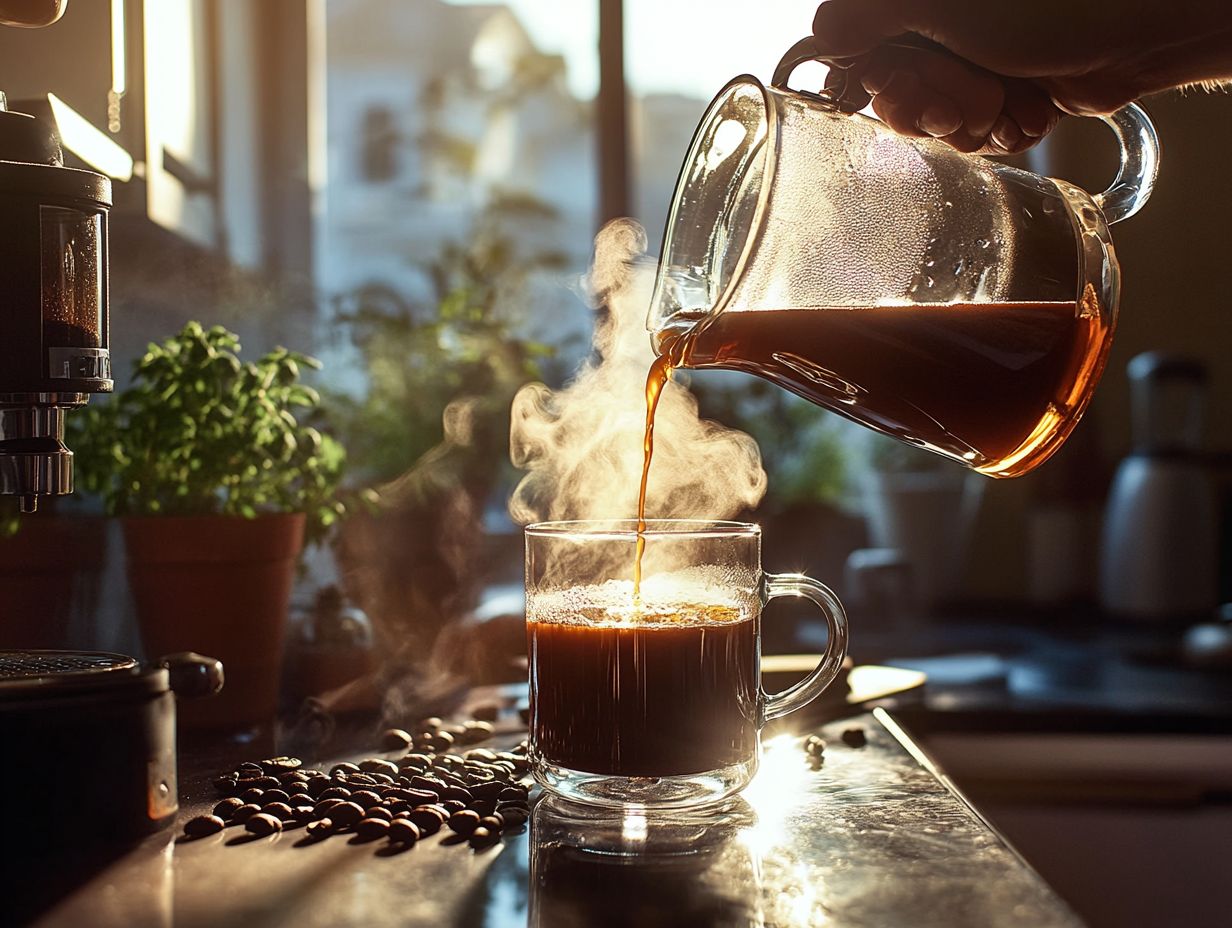
What is the role of aroma in home brewing?
Aroma plays a crucial role in the overall taste and enjoyment of your home brewed beer. It provides enticing scents that enhance flavor and create a more satisfying drinking experience, particularly in hop-forward beers like IPA and NEIPA.
How can I maximize the aroma in my home brewed beer?
To maximize the aroma in your home brewed beer, use fresh, high-quality ingredients and incorporate the right techniques during brewing. This includes adding hops at the correct time and temperature, using the right amount of yeast, and properly conditioning the beer. Consider methods like dry hopping, using a mesh bag for hop additions, and ensuring your hops are nitrogen-flushed for maximum freshness.
What ingredients are best for achieving a strong aroma in my beer?
To achieve a strong aroma in your beer, use aromatic hop varieties such as Citra, Mosaic, Simcoe, Amarillo, Cascade, and Falconer s Flight. Selecting the right yeast strain like Kveik or using a single malt and single hop (SMaSH) approach can also enhance aromatic qualities.
Hops are the main ingredient responsible for aroma in beer. Choose varieties like Citra, Mosaic, and Simcoe, which have high essential oil content, and add them at the end of the boiling process or during dry hopping for maximum impact. Specialty malts and adjuncts can also contribute to the aroma profile of your beer. Use well-preserved hops stored in nitrogen-flushed bags to maintain potency.
Is it possible to add aroma to my beer after it has been brewed, such as in an IPA or NEIPA?
Yes, you can add aroma to your beer after brewing! This is done by adding hops after brewing, a process known as dry hopping.
You can also experiment with adding flavor extracts or essential oils to elevate your beer’s aroma before bottling or kegging. Hop tea and hop basket methods are also great for hop-forward beers!
Are there any tips for preserving the hop aroma in my home brewed beer?
To keep the hop aroma in your home brewed beer, store it in a cool, dark place and limit oxygen exposure. Bottling or kegging with minimal headspace helps retain aroma.
You can also use techniques like steep additions and natural cooling to help maintain the aroma. For the best experience, drink your beer within a few weeks of bottling or kegging!
Can using certain types of yeast affect the aroma and flavor profiles of my beer?
Yes! Different yeast strains have a big impact on both aroma and flavor. Choosing the right yeast is essential for the aroma you want.
Some strains, like Kveik, produce fruity or spicy aromas. This can enhance the complexity of hop-forward beers, while others have a neutral scent. Your choice of yeast significantly influences the brewing experience!

